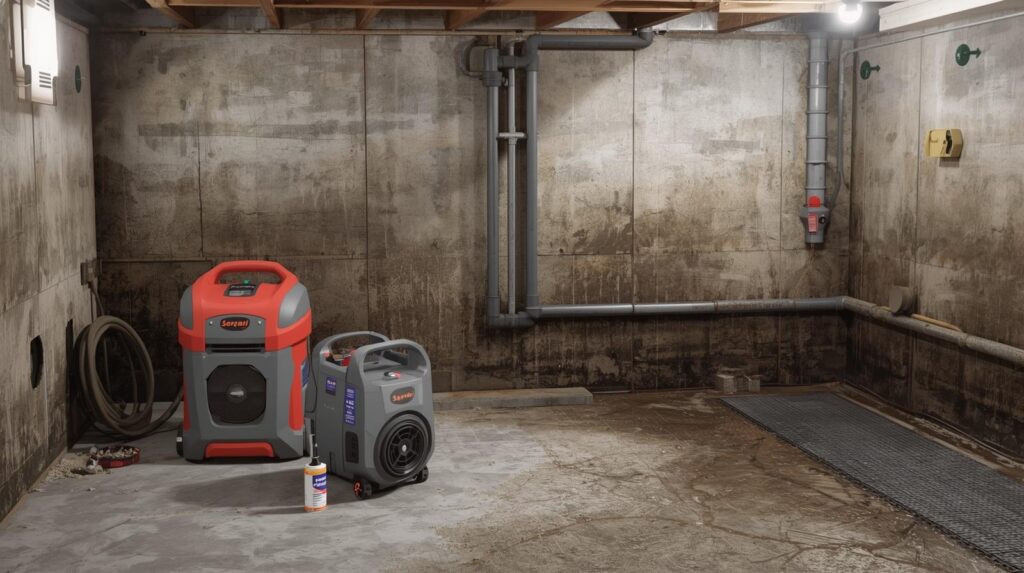A dry basement is more than just extra storage space; it’s the foundation of your home’s structural integrity, air quality, and overall value. Discovering a puddle, a musty smell, or the dreaded white, chalky residue (efflorescence) on your basement walls can send any homeowner into a panic. The good news is that with the right knowledge and approach, achieving a permanently dry basement is entirely possible.
Successful basement waterproofing isn’t about a single magic fix. It’s a systematic process of diagnosis and solution. To help you protect your investment and your peace of mind, here are five essential tips for basement waterproofing success.
1. Diagnose the Source, Don’t Just Treat the Symptom
This is the most critical rule of basement waterproofing. It’s tempting to see water on the floor and immediately reach for a sealant or a new sump pump. However, water is a relentless force that will always find the path of least resistance. If you only address where the water is appearing (the symptom) and not how it’s getting in (the source), the problem will inevitably return, often with greater severity.
How to Properly Diagnose:
Look for Clues: Is the water seeping up through the floor joint or coming in through the walls? Are there active drips from a foundation crack repair that was previously done? Is the moisture present only during heavy rain or is it constant?
Identify Water Types:
Subsurface Water: This is water from a rising water table, which puts pressure on your foundation floor and walls (hydrostatic pressure). This often requires an interior drainage system.
Surface Water: This is water from rain or downspouts that is pooling against your foundation. This is usually the easiest and most cost-effective to fix by improving grading and gutter systems.
Condensation: Sometimes, what looks like a leak is simply moisture in the warm air condensing on cool basement surfaces. This requires dehumidification and better ventilation, not waterproofing.
Taking the time to correctly identify the source will save you thousands of dollars and countless headaches by ensuring you invest in the right solution from the start.
2. Start from the Outside: The First Line of Defense
The most effective and permanent form of basement waterproofing is to stop water before it ever touches your foundation. This is known as outside basement waterproofing. Think of your home as a tent; if you pour a bucket of water on the roof, it runs off the sides. If the sides are sealed and the ground slopes away, the water never gets in.
Key Components of Exterior Waterproofing:
Proper Grading: The ground around your foundation should slope away from your house for at least 6-10 feet. Over time, soil settles and can create a “bowl” effect that directs water toward your foundation. This is a low-basement waterproofing cost fix with a huge payoff.
Gutter and Downspout Maintenance: Clogged or broken gutters dump massive amounts of water right at your foundation walls. Ensure your gutters are clean and that downspout extensions direct water at least 4-6 feet away from your house.
Exterior Drainage Membranes: For new construction or major renovations, a dimpled plastic membrane can be applied to the exterior foundation walls. This protects the waterproof coating from backfill damage and creates a channel for water to drain down to the footing drains.
While interior solutions are often necessary, never underestimate the power of managing water on the outside. It’s your primary shield.
3. Don’t Ignore the Cracks: Professional Foundation Crack Repair
Hairline cracks in concrete are common, but any crack that is actively leaking is a major red flag. Water pressure can widen these cracks over time, leading to more significant structural issues. DIY epoxy or hydraulic cement injections are often temporary fixes because they don’t address the pressure behind the crack and can fail as the foundation naturally shifts.
Professional foundation crack repair is the only way to ensure a permanent seal. The gold standard method is an epoxy or polyurethane injection performed by a professional.
Epoxy Injection: Used for structural, non-leaking cracks. It bonds the concrete back together, restoring the wall’s original strength.
Polyurethane Injection: A flexible, expanding foam that is perfect for actively leaking cracks. It creates a watertight seal that can flex with minor foundation movement.
Investing in professional foundation crack repair not only stops the water but also preserves the structural bones of your home, protecting its long-term value.
4. Understand the Interior Solutions: Your Last Line of Defense
When exterior measures aren’t enough or aren’t feasible, interior systems are your reliable last line of defense. These systems don’t stop water from entering the foundation, but they manage it once it’s inside, channeling it safely away.
The most effective interior system is an interior drain tile (or French drain) coupled with a sump pump.
Interior Drain Tile: A perforated pipe is installed along the interior perimeter of the foundation, buried beneath the basement floor. It collects water that seeps in through the walls or floor.
Sump Pump: The collected water in the drain tile flows to a sump pit. A sump pump then automatically activates and pumps this water out and away from your house.
This system relieves hydrostatic pressure under your floor, effectively making your basement a “boat” that water can flow under but not into. While this is one of the more involved solutions and impacts the overall basement waterproofing cost, it is one of the most reliable for chronic water issues.
5. Get Multiple Quotes and Ask the Right Questions
Basement waterproofing is a significant investment, and the industry, unfortunately, has its share of unscrupulous contractors. Protecting yourself starts with due diligence.
Get at Least 3 Detailed Quotes: Don’t just go with the first or cheapest option. A reputable company will offer a free, detailed inspection and provide a written quote that breaks down the scope of work, materials, and warranty information.
Ask About Warranties: A trustworthy company will stand behind its work. Ask about the specifics of their warranty. Is it transferable to the next homeowner? What does it cover? A strong warranty is a sign of confidence in their workmanship.
Check Credentials: Are they licensed, insured, and bonded? Do they have positive reviews on independent sites like the Better Business Bureau (BBB) or Google?
Be Wary of Scare Tactics: If a contractor uses high-pressure sales tactics or tries to scare you with “imminent structural collapse” without clear evidence, show them the door. A professional will educate you, not intimidate you.
Understanding the different approaches and their associated costs will empower you to make an informed decision. The basement waterproofing cost can vary widely based on the size of your home, the severity of the problem, and the solution required, so getting multiple perspectives is crucial.
Conclusion: A Dry Basement is an Achievable Goal
A wet basement doesn’t have to be a fact of homeownership. By following these five essential tips—starting with a proper diagnosis, prioritizing exterior solutions, addressing cracks professionally, understanding interior systems, and choosing your contractor wisely—you can achieve basement waterproofing success.
Remember, the goal is to create a comprehensive system that manages water at every stage, from your roofline to the interior drainage. Investing in a permanent solution not only gives you back usable space but also provides invaluable peace of mind, knowing your home’s foundation is secure and protected for years to come.


